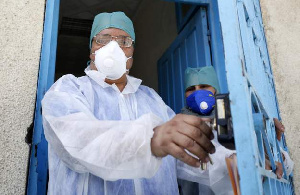Opinions of Thursday, 26 March 2020
Columnist: Dr. Wil Agbenyikey
Break the Chain: Wear a mask!
As we have now learned that, through coughing or sneezing, a COVID-19 infected person can transmit the virus to another person possibly in an aerosol form, or anything close to it, where it may stay in the air for a much longer period of time.
This possible mode of transmission makes the virus infection a real game changer contrary to the earlier narrative that the infection is through droplets. A peer-reviewed article published in New England medical journal found that COVID-19(known as SAS-CoV-2) has the capability to be viable in the air for as long as 3 hours [van Doremalen et.al. 2020].
This study and others [Liu et.al. 2020, SWX Ong et al 2020] convince me there’s a likely capability of COVID-19 transmission through the air long after an infected person coughs or sneezes, especially in an indoor public place. In light of this new evidence, I believe an additional recommendation of wearing masks by everyone in public places, and not frontline health workers alone, especially now that our efforts are being exhausted in reducing the effective reproductive number regardless of a relatively lower basic reproductive number, but less avail.
I see two challenges here: first, lack of availability of approved masks for everyone, especially now that we must prevent a shortage of approved masks for health frontline workers. Second, the improper wearing of the mask and prevention of touching your face at a higher frequency than usual when you have the mask on.
DIY masks:
To solve the first challenge, for those who do not currently have masks, we can make our own home-made masks from common household materials such as pillowcases and cotton shirts [Davis et.at. 2013].
Thankfully, scientists from Cambridge University, UK tested the effectiveness of many household materials and concluded that a wide range of household materials are more than capable of competing with n95 masks in reducing the exposure to COVID-19.
In this study, the authors tested the percentage of virus that can be blocked from transmission by household materials using a much smaller virus in size, bacteriophage (0.02 microns), which is even 5 times smaller than the size of this novel coronavirus by using dish towels, 100% cotton shirt, and pillowcases.
Surgical masks blocked 89% of the 0.02 microns, kitchen dish towels blocked 73%, cotton blend shirts blocked 70%, pillowcase blocked 68% and linen blocked 62%.
In perspective, the n95 mask that WHO recommends blocks 95 per cent of 0.3-micron test particles including viruses [US FDA]. Other qualities of a mask are their breathability and pressure drop. According to the Cambridge scientists, cotton and bedsheets had the best of these qualities and hence can be worn for longer periods of time.
Wearing of mask and preventing frequent touching of face:
We need to train people to properly wear a mask. After all, inexperienced family members who are caretakers of their COVID-19 patients are wearing them. Even before COVID-19 outbreak, people use to wear masks for many reasons. Due to the explosion of this outbreak, this is the time to rally people to wear more masks, especially if we are making them from home to prevent shortage for frontline health workers.
I say, with the utmost common sense in me, that the masks (including DIY masks) provide a barrier from not only respiratory droplets but aerosolized COVID-19 which can stay in the air and be viable for 3 hours. Having anecdotal evidence supporting the effectiveness of masks against the virus lends itself that it may work for people so we should not dismiss its use in this much needed situation.
I’ll entreat all to go on YouTube to learn how to make your own mask, with or without sewing. Be sure to use the materials recommended
More importantly, let’s treat ourselves as if we have the virus, treat everyone as if they have the virus, and treat every surface as if contaminated with the virus.
Dr. Wil Agbenyikey - Environmental Epidemiologist
Email:[email protected]











